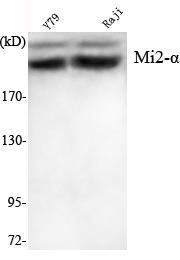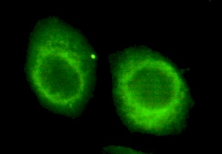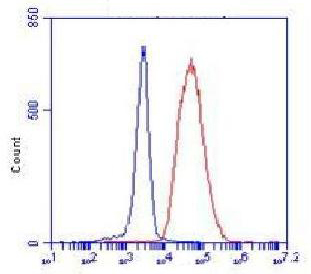Mi2-α Monoclonal Antibody
- Catalog No.:YM1062
- Applications:WB;IHC;IF;FCM
- Reactivity:Human;Mouse;Rat;Bovine;Dog;Pig
- Target:
- Mi2-α
- Gene Name:
- CHD3
- Protein Name:
- Chromodomain-helicase-DNA-binding protein 3
- Human Gene Id:
- 1107
- Human Swiss Prot No:
- Q12873
- Immunogen:
- Purified recombinant human Mi2-α (C-terminus) protein fragments expressed in E.coli.
- Specificity:
- Mi2-α Monoclonal Antibody detects endogenous levels of Mi2-α protein.
- Formulation:
- Liquid in PBS containing 50% glycerol, 0.5% BSA and 0.02% sodium azide.
- Source:
- Monoclonal, Mouse
- Dilution:
- WB 1:1000 - 1:2000. IHC 1:500 - 1:1000. IF 1:100 - 1:500. Flow cytometry: 1:100 - 1:200. Not yet tested in other applications.
- Purification:
- Affinity purification
- Concentration:
- 1 mg/ml
- Storage Stability:
- -15°C to -25°C/1 year(Do not lower than -25°C)
- Other Name:
- CHD3;Chromodomain-helicase-DNA-binding protein 3;CHD-3;ATP-dependent helicase CHD3;Mi-2 autoantigen 240 kDa protein;Mi2-alpha;Zinc finger helicase;hZFH
- Molecular Weight(Da):
- 227kD
- Background:
- This gene encodes a member of the CHD family of proteins which are characterized by the presence of chromo (chromatin organization modifier) domains and SNF2-related helicase/ATPase domains. This protein is one of the components of a histone deacetylase complex referred to as the Mi-2/NuRD complex which participates in the remodeling of chromatin by deacetylating histones. Chromatin remodeling is essential for many processes including transcription. Autoantibodies against this protein are found in a subset of patients with dermatomyositis. Three alternatively spliced transcripts encoding different isoforms have been described. [provided by RefSeq, Jul 2008],
- Function:
- disease:One of the main antigens reacting with anti-MI-2 positive sera of dermatomyositis.,function:Probable transcription regulator.,sequence caution:Differs from position 1967 onward for unknown reasons.,similarity:Belongs to the SNF2/RAD54 helicase family.,similarity:Contains 1 helicase ATP-binding domain.,similarity:Contains 1 helicase C-terminal domain.,similarity:Contains 2 chromo domains.,similarity:Contains 2 PHD-type zinc fingers.,subunit:Central component of the nucleosome remodeling and histone deacetylase (NuRD) repressive complex. Interacts with TRIM28 and SERBP1. Interacts via its C-terminal region with HABP4.,tissue specificity:Widely expressed.,
- Subcellular Location:
- Nucleus, PML body . Nucleus . Cytoplasm, cytoskeleton, microtubule organizing center, centrosome . Associates with centrosomes in interphase and mitosis. .
- Expression:
- Widely expressed.
- June 19-2018
- WESTERN IMMUNOBLOTTING PROTOCOL
- June 19-2018
- IMMUNOHISTOCHEMISTRY-PARAFFIN PROTOCOL
- June 19-2018
- IMMUNOFLUORESCENCE PROTOCOL
- September 08-2020
- FLOW-CYTOMEYRT-PROTOCOL
- May 20-2022
- Cell-Based ELISA│解您多样本WB检测之困扰
- July 13-2018
- CELL-BASED-ELISA-PROTOCOL-FOR-ACETYL-PROTEIN
- July 13-2018
- CELL-BASED-ELISA-PROTOCOL-FOR-PHOSPHO-PROTEIN
- July 13-2018
- Antibody-FAQs
- Products Images

- Western Blot analysis using Mi2-α Monoclonal Antibody against Y7P, Raji cell lysate.

- Immunohistochemistry analysis of paraffin-embedded human colon using Mi2-α Monoclonal Antibody.

- Immunofluorescence analysis of HeLa cells using Mi2-α Monoclonal Antibody.

- Flow cytometric analysis of K562 cells stained with Mi2-α Monoclonal Antibody (red), followed by FITC-conjugated goat anti-mouse IgG. Blue line histogram represents the isotype control, normal mouse IgG.



